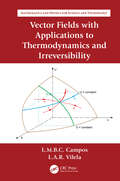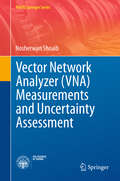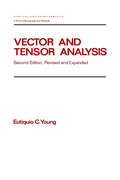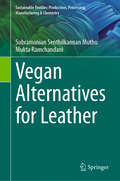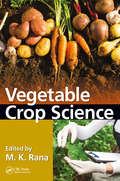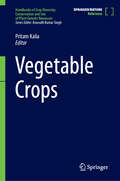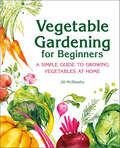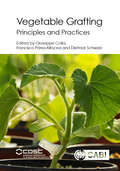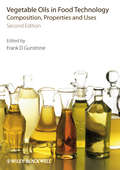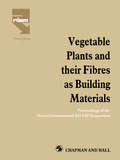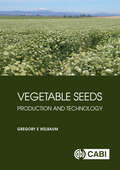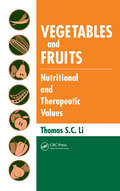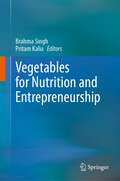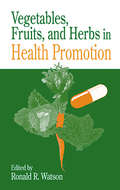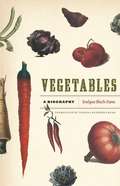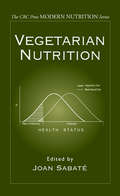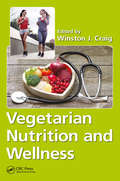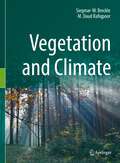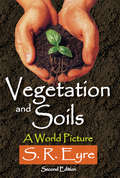- Table View
- List View
Vector Fields with Applications to Thermodynamics and Irreversibility (Mathematics and Physics for Science and Technology #10)
by Luis Manuel Braga da Costa Campos Luís António Raio VilelaVector Fields with Applications to Thermodynamics and Irreversibility is part of the series "Mathematics and Physics for Science and Technology", which combines rigorous mathematics with general physical principles to model practical engineering systems with a detailed derivation and interpretation of results. Volume V presents the mathematical theory of partial differential equations and methods of solution satisfying initial and boundary conditions, and includes applications to: acoustic, elastic, water, electromagnetic and other waves; the diffusion of heat, mass and electricity; and their interactions. This is the first book of the volume. The second book of volume V continues this book on thermodynamics, focusing on the equation of state and energy transfer processes including adiabatic, isothermal, isobaric and isochoric. These are applied to thermodynamic cycles, like the Carnot, Atkinson, Stirling and Barber-Brayton cycles, that are used in thermal devices, including refrigerators, heat pumps, and piston, jet and rocket engines. In connection with jet propulsion, adiabatic flows and normal and oblique shock waves in free space and nozzles with variable cross-section are considered. The equations of fluid mechanics are derived for compressible two-phase flow in the presence of shear and bulk viscosity, thermal conduction and mass diffusion. The thermodynamic cycles are illustrated by detailed calculations modelling the operation of piston, turbojet and rocket engines in various ambient conditions, ranging from sea level, the atmosphere of the earth at altitude and vacuum of space, for the propulsion of land, sea, air and space vehicles. The book is intended for graduate students and engineers working with mathematical models and can be applied to problems in mechanical, aerospace, electrical and other branches of engineering dealing with advanced technology, and also in the physical sciences and applied mathematics. This book: Simultaneously covers rigorous mathematics, general physical principles and engineering applications with practical interest Provides interpretation of results with the help of illustrations Includes detailed proofs of all results L.M.B.C. Campos was chair professor and the Coordinator of the Scientific Area of Applied and Aerospace Mechanics in the Department of Mechanical Engineering and also the director (and founder) of the Center for Aeronautical and Space Science and Technology until retirement in 2020. L.A.R.Vilela is currently completing an Integrated Master's degree in Aerospace Engineering at Institute Superior Tecnico (1ST) of Lisbon University.
Vector Network Analyzer (VNA) Measurements and Uncertainty Assessment
by Nosherwan ShoaibThis book describes vector network analyzer measurements and uncertainty assessments, particularly in waveguide test-set environments, in order to establish their compatibility to the International System of Units (SI) for accurate and reliable characterization of communication networks. It proposes a fully analytical approach to measurement uncertainty evaluation, while also highlighting the interaction and the linear propagation of different uncertainty sources to compute the final uncertainties associated with the measurements. The book subsequently discusses the dimensional characterization of waveguide standards and the quality of the vector network analyzer (VNA) calibration techniques. The book concludes with an in-depth description of the novel verification artefacts used to assess the performance of the VNAs. It offers a comprehensive reference guide for beginners to experts, in both academia and industry, whose work involves the field of network analysis, instrumentation and measurements.
Vector and Tensor Analysis (Pure and Applied Mathematics #172)
by Eutiquio C. Young<p>Revised and updated throughout, this book presents the fundamental concepts of vector and tensor analysis with their corresponding physical and geometric applications - emphasizing the development of computational skills and basic procedures, and exploring highly complex and technical topics in simplified settings. <p>This text: incorporates transformation of rectangular cartesian coordinate systems and the invariance of the gradient, divergence and the curl into the discussion of tensors; combines the test for independence of path and the path independence sections; offers new examples and figures that demonstrate computational methods, as well as carify concepts; introduces subtitles in each section to highlight the appearance of new topics; provides definitions and theorems in boldface type for easy identification. It also contains numerical exercises of varying levels of difficulty and many problems solved.</p>
Vegan Alternatives for Leather (Sustainable Textiles: Production, Processing, Manufacturing & Chemistry)
by Subramanian Senthilkannan Muthu Mukta RamchandaniEnvironmental toxicity and sustainability are major areas of research for the leather industry, as well as for the larger luxury and fashion industry. Several alternatives to traditional animal-based leather have been introduced in the market as “vegan” leather, e.g. the pineapple skin leather Piñatex, mycelium (mushroom leather), apple leather, cactus leather, and PU/PVC faux leather. However, a clear assessment of the sustainability (e.g. carbon/water footprint, LCA) for these alternatives is missing. The aim of this book is to provide clarity and a coherent structural assessment of sustainable vegan or vegetarian alternatives of leather. This book contributes to the current research within sustainability and environmental impact, production, and consumption aspects of these materials.
Vegetable Brassicas and Related Crucifers (Crop Production Science in Horticulture Series #14)
by Geoffrey R. DixonThe Brassica crops provide the greatest diversity of products derived from a single genus. As vegetables they deliver leaves, flowers, stems and roots that are used either fresh or in processed forms. This book covers the Occidental crops derived from B. oleracea(cole or cabbage group) and Oriental types from B. rapa (Chinese cabbage and its relatives). Both groups are of immense importance for human nutrition, containing vital vitamins and cancer-preventing substances.
Vegetable Crop Science
by M. K. RanaThis book has been prepared to provide every production aspect of important vegetables along with information regarding origin and distribution, composition and uses, botany, varieties, climatic and soil requirement, cultivation practices, harvesting, post-harvest management, insect-pests and diseases along with their control measures. Its users would find this book very practical for raising vegetable crops profitably.
Vegetable Crops (Handbooks of Crop Diversity: Conservation and Use of Plant Genetic Resources)
by Pritam KaliaThe volume on Vegetable Crops as a part of series entitled “Handbooks of Crop Diversity: Conservation and Use of Genetic Resources” will be a unique resource, first of its kind, which will elaborate on origin, evolution, taxonomy, identification, chemical characterization, and genetic improvement of Vegetable Crop Plants. Vegetable crops are an important group of crops comprising solanaceous vegetables, Cole crops, Cucurbitaceous crops, Bulb crops, Root crops, Tuber crops, legume vegetables, leafy & salad vegetables, Okra etc. There is tremendous diversity within each group of vegetable crops. This genetic diversity is from the point of view of landraces and varieties of vegetable crops species used for food, processing, nutraceuticals, pharmaceuticals, etc. Vegetables being an integral part of human diet being rich source of diverse nutrients such as vitamins, minerals and antioxidants, they play an important role in balancing the diet and tackling malnutrition. Besides, due to their intensive cultivation, they also play an important role in enhancing per unit area production and productivity, cropping intensity enhancing, thereby, the farmers income, especially that of small and marginal farmers, and providing job opportunities. The genetic improvement of vegetable crops facilitate continued breeding of varieties with greater resilience to stresses and productivity is mainly dependent on overall genetic variation found in individuals belonging to the cultivated species and/or ancestral species related to cultivated species of vegetable crops. Since genes of interest can be tapped from plant sources for their introduction through controlled breeding processes for genetic improvement, and incorporating of desirable external and internal quality traits, therefore accessibility to the information about these plant genetic resources is key to the success of the breeding efforts. Since there is a need of comprehensive information about the genetic resources, therefore it is important to facilitate their conservation and long-term sustainable use in research and improvement. The comprehensive information on the availability of genetic diversity in each vegetable crop species in this volume would facilitate priority conservation in gene banks, research and use in vegetable crop improvement. Realizing the importance of genetic variability in the improvement of vegetable crops from the point of view of biotic and abiotic stress resistance, enhanced micronutrient, climate change, enhanced shelf life, nutraceuticals, bioactive compounds, especially national and international efforts further need to be stepped up for collection, characterization, evaluation, and conservation of vegetable crops genetic resources to facilitate search for new genes, research and their use in vegetable crops improvement. During 21st century, genomics and marker assisted tools have gained importance for hastening the crop improvement programmes by enhancing breeding efficiency. Realizing that population in South Asia and Southeast Asia is facing acute problem of under and malnutrition, the emphasis on dietary diversification with vegetables is therefore being stressed. Besides, to enhance farmers income much emphasis is being laid on development of varieties having diverse maturity, growth habit, resistance to diseases and insect pest to reduce the use pesticides, enhanced nutrients and shelf life. For these traits, we have to look into landraces, and wild relatives for the traits of interest. Therefore, it has been felt to bring out a vegetable volume with additional accessory and supplemental information, analyses and specifically filtered information which can go a long way in promoting research, search for new genes/alleles, revealing the opportunities available for exploitation of PGR in generation of cultivars to meet upcoming challenges of vegetable crop improvement and diversification and requirement of cultivars for processing, nutraceutical and pharma
Vegetable Diseases: A Colour Handbook
by Steven T. Koike Peter Gladders Albert PaulusOur dependence on healthy vegetable crops as a reliable source of food transcends all barriers of nation and culture. Consumers now demand excellent quality from the industry that produces large volumes of high quality vegetables to be sold locally, regionally and shipped internationally. The diseases that affect vegetables compromise such quality
Vegetable Fats and Oils: The Utilisation Of Volatile Compounds In The Characterisation Of Vegetable Oils And Fats And In Reducing The Bacterial Count Of Ambient Air
by Sabine KristThis encyclopedia scientifically describes 121 vegetable oils and fats. In addition to conventional oils, the book also covers lesser-known oils such as Amaranth, Chia, prickly pear, and quinoa. Author pays particular attention to root plants, extraction, and the ingredients included in information nutritionally relevant to fatty acid patterns. Applications in pharmacology, medicine, cosmetics and technology, as well as possible adverse effects, are discussed. The thoroughly researched reference book includes detailed descriptions along with the latest research results and methods.
Vegetable Fiber Composites and their Technological Applications (Composites Science and Technology)
by Mohammad Jawaid Anish KhanThis book explores vegetable fiber composite as an eco-friendly, biodegradable, and sustainable material that has many potential industrial applications. The use of vegetable fiber composite supports the sustainable development goals (SDGs) to utilize more sustainable and greener composite materials, which are also easy to handle and locally easily available with economical production costs. This book presents various types of vegetable fiber composite and its processing methods and treatments to obtain desirable properties for certain applications. The book caters to researchers and students who are working in the field of bio-composites and green materials.
Vegetable Gardening for Beginners: A Simple Guide to Growing Vegetables at Home
by Jill McSheehyGrow a flourishing vegetable garden this summer with the ultimate guide to gardening for beginners.Gardeners never forget the first time they enjoyed a ripe, juicy tomato plucked straight from the vine or savored a crisp, fresh salad made with ingredients from their backyard. Start growing your first crop today with Vegetable Gardening for Beginners. Taking up vegetable gardening can be a worthwhile summer activity, and an ideal summer hobby for people of all ages.Host of The Beginner's Garden podcast Jill McSheehy offers simple guidance to first-time gardeners who will be amazed at how easy it can be to create a thriving garden.Build the ideal foundation with clear instructions for constructing raised beds, preparing containers, and mixing healthy soil.Pick the perfect plants with in-depth profiles that detail how to grow beloved culinary plants, from peppery arugula to cool melons and fragrant rosemary.Nurture a budding garden with this reference for pairing up companion plants, watering and mulching, handling pests, and maintaining plants year-round.Start your own vegetable garden with the easy-to-follow guidance from Vegetable Gardening for Beginners.
Vegetable Grafting
by Giuseppe Colla Francisco Pérez-Alfocea Dietmar SchwarzThis book provides comprehensive, current scientific and applied practical knowledge on vegetable grafting, a method gaining considerable interest that is used to protect crops from soil-borne diseases, abiotic stress and to enhance growth/yield. Though the benefits of using grafted transplants are now fully recognized worldwide, understanding the rootstock/scion interactions under variable environmental pressures remains vital for grafting-mediated crop improvement. Vegetable Grafting: Principles and Practices covers: #65533; Breeding, signalling, and physiological and molecular mechanisms involved in grafting #65533; Beneficial effects of grafting including reducing disease damage and abiotic stress; #65533; Effects relating to the impact of grafting on fruit quality #65533; Applications and speciality crops. Including high-quality colour images and written by an international team of expert authors, this book provides up-to-date scientific data and is also concerned with translating science to the field. It is an essential resource for researchers, advanced technicians, practitioners and extension workers.
Vegetable Oil-Based Composites: Processing, Properties and Applications (Composites Science and Technology)
by Mohammad Jawaid Anish Khan Showkat Ahmad Bhawani Mohmad Nasir Mohmad IbrahimThis book presents the latest developments in the field of vegetable oil -based composites. It focuses on different vegetable oils such as castor, linseed, corn, soybean, olive, palm, and canola oils;, and fillers from inorganic materials and agricultural residues used in the preparation of vegetable oil -based composites. There are several advantages to vegetable oil-based polymer composites, due to their universal availability, inherent biodegradability, low price, and superb environmental credentials (i.e., low eco-toxicity and low toxicity towards humans). This book will be of is of interest to researchers working in the field of bio-based composite materials for the development of green and sustainable materials.
Vegetable Oils in Food Technology: Composition, Properties and Uses (Sheffield Chemistry And Technology Of Oils And Fats Ser.)
by Frank D. GunstoneOur dietary intake comprises three macronutrients (protein, carbohydrate and lipid) and a large but unknown number of micronutrients (vitamins, minerals, antioxidants, etc). Good health rests, in part, on an adequate and balanced supply of these components. This book is concerned with the major sources of lipids and the micronutrients that they contain. Now in an extensively updated second edition, the volume provides a source of concentrated and accessible information on the composition, properties and food applications of the vegetable oils commonly used in the food industry. Chapters are devoted to each type of oil, and an introductory chapter by the Editor provides an overview of the current production and trade picture globally. The book includes coverage of the modifications of these oils that are commercially available by means of partial hydrogenation, fractionation and seed breeding. The major food applications are linked, wherever possible, to the composition and properties of the oils. This new edition widens the range of oils covered, addresses issues related to trans fats reduction, and new composition data is included throughout. The book is an essential resource for food scientists and technologists who use vegetable oils in food processing; chemists and technologists working in oils and fats processing; and analytical chemists and quality assurance personnel. Praise for the first edition: "This excellent book consists of 337 pages in 11 chapters, written by 13 experts from six countries...the important vegetable oils are dealt with in great detail. With obesity on all out lips...this book also rightly defends itself and its content - namely, that all vegetable oils, when used correctly and of course in moderation, are indeed necessary to all of us." –Food & Beverage Reporter "Overall, the book covers all of the major oils which the potential reader is likely to approach it for... covers a wide range of topics from production, through composition to nutritional aspects... The volume is well indexed, particularly for the individual subject oils, and it is easy to find specific topics within its chapters." –Food Science and Technology "This latest book edited by Professor Gunstone belongs to the kind of books where the reader rapidly knows it will bring him a wealth of updated information concentrated in one book. The goal to 'serve as a rich source of data' on the thirteen major oils and their important minor components has been attained. There is a need for books of such quality." –European Journal of Lipid Science and Technology
Vegetable Plants and their Fibres as Building Materials: Proceedings of the Second International RILEM Symposium
by H. S. SobralThis book examines the state-of-the-art on plants and fibres as building materials for low cost construction, emphasizing their use, properties, fabrication, new procedures and future developments. It makes available research results on new techniques for fibre reinforcement and their use in concrete, stabilized clay and other matrices. Procedures for making vegetable fibres and wood-based building materials in developing countries are also analysed.
Vegetable Seeds: Production and Technology
by Gregory E WelbaumMost food and fiber crops are produced from seed. This means that the world's population is dependent on annual seed production for its food supply. Vegetable seed production is much different and more challenging than production of grain crops. This book explains the biology and technology behind producing, maintaining, and enhancing the quality of vegetable seeds from breeding through to the marketed product. It begins with six chapters on a broad range of seed-related topics: the importance of seeds, reproductive biology of plants, genetic improvement strategies, quality assurance of seed production, post-harvest seed enhancement, and organic production. The remaining chapters cover seed production in eleven important vegetable families. Each chapter provides a description of the botany, types and cultivars, genetic improvement, pollination, soil fertility management, pest management, crop production, harvesting, post-harvest handling, and seed yields. The aim of this book is to educate how to produce high-quality vegetable seeds. Incorporating both current methodologies and recent research results, it is suitable for students, researchers, and professionals in the seed industry.
Vegetables and Fruits: Nutritional and Therapeutic Values
by Thomas S. LiThe modern synthetic diet, formulated to appeal to our inherent attraction to sugar, salt, fats, and calories at the expense of nutrition, leaves us over-fed and under-nourished. A considerable portion of chronic human diseases, including diabetes and heart disease, appear to be related largely to a diet that is inadequate in the essential vitamins
Vegetables for Nutrition and Entrepreneurship
by Brahma Singh Pritam KaliaThis edited book is compiled by renowned Horticultural scientist Padma Shri Prof. Brahma Singh and Former Head of Vegetable Science Division, ICAR-IARI, New Delhi Dr Pritam Kalia. The book is mainly focused on two aspects of vegetable crops – nutrition and entrepreneurial potential. The book explains the importance of vegetables crops as essential food items for managing food security and malnutrition. Since vitamins and minerals deficiency is on the increase globally, this book highlights the presence and availability of essential nutrients, vitamins in addition to other food constituents necessary for human health. The book also emphasizes on the potential of vegetables crops as an affordable avenue for entrepreneurial ventures. It explains the important steps in respect of vegetable crops, such as production, harvesting, packaging, transport, storage, marketing of fresh vegetables, processing and value-addition etc. The book chapters are written in simple language with recent scientific developments by the experienced and acknowledged scientists in the field. The book is a useful reading material for curriculum and examination requirements of undergraduate and postgraduate, and other university examinations. It is also of interest to professionals, researchers, policy makers and potential entrepreneurs in the field of vegetable crop farming
Vegetables, Fruits, and Herbs in Health Promotion
by Ronald R. WatsonThe use of dietary vegetables and medicinal herbs to improve health is a phenomenon that is taking society by storm. Herbal products are now a multi-billion dollar business. Even more important, this business is built upon extremely little research data. The FDA is pushing the industry-with Congress' help- to base their claims and products on scien
Vegetables: A Biography
by Evelyne Bloch-DanoFrom Michael Pollan to locavores, Whole Foods to farmers' markets, today cooks and foodies alike are paying more attention than ever before to the history of the food they bring into their kitchens—and especially to vegetables. Whether it’s an heirloom tomato, curled cabbage, or succulent squash, from a farmers' market or a backyard plot, the humble vegetable offers more than just nutrition—it also represents a link with long tradition of farming and gardening, nurturing and breeding.In this charming new book, those veggies finally get their due. In capsule biographies of eleven different vegetables—artichokes, beans, chard, cabbage, cardoons, carrots, chili peppers, Jerusalem artichokes, peas, pumpkins, and tomatoes—Evelyne Bloch-Dano explores the world of vegetables in all its facets, from science and agriculture to history, culture, and, of course, cooking. From the importance of peppers in early international trade to the most recent findings in genetics, from the cultural cachet of cabbage to Proust’s devotion to beef-and-carrot stew, to the surprising array of vegetables that preceded the pumpkin as the avatar of All Hallow’s Eve, Bloch-Dano takes readers on a dazzling tour of the fascinating stories behind our daily repasts.Spicing her cornucopia with an eye for anecdote and a ready wit, Bloch-Dano has created a feast that’s sure to satisfy gardeners, chefs, and eaters alike.
Vegetarian Nutrition (Modern Nutrition)
by Joan SabatéApproximately 12 million U.S. citizens consider themselves vegetarians, and 13.5 percent of all U.S. households claim to have at least one family member practicing some form of vegetarianism. In the past 30 years, scientific endeavors in the area of vegetarian nutrition have progressively shifted from investigating dietary concerns held by nutritio
Vegetarian Nutrition and Wellness
by Winston J. CraigA large amount of research effort goes into assessing the health benefits of a plant-based diet, resulting from human desire to consume a more sustainable diet that is less destructive of the earth’s natural resources. In addition, a growing number of people are choosing the vegan or total vegetarian diet because of the potential to greatly reduce the risk of chronic diseases and mortality rates. Although this interest in plant-based eating is popular, there exist concerns on the safety of some vegetarian diets, especially a vegan diet. This book describes issues of the vegetarian diet and outlines ways to prevent nutrient deficiencies. Vegetarian Nutrition and Wellness focuses on synthesizing research around vegetarian diets and human health. A major section of the book deals with how a vegetarian diet protects population groups from the major chronic diseases, such as cardiovascular diseases, obesity, and various cancers. Based upon ecological and clinical studies, chapter authors explain the health-promoting properties of plant-based diets, and compare/contrast health outcomes obtained from consuming omnivorous diets with a vegetarian or vegan diet. Fruits and vegetables figure prominently in vegetarian diets and provide a substantial effect in disease reduction and health-promoting properties of a plant-based diet. Vegetarian Nutrition and Wellness is written for the academic community, registered dietitians, health professionals, and graduate students in nutrition and public health. Each chapter provides a comprehensive review of the scientific literature and includes a concise summary at the beginning of each chapter. The time is ripe for this book to update the scientific community with a collage of well-documented topics on vegetarian nutrition.
Vegetation Dynamics
by Qiang Yu Derek Eamus Alfredo Huete Eamus, Derek and Huete, Alfredo and Yu, QiangUnderstanding ecosystem structure and function requires familiarity with the techniques, knowledge and concepts of the three disciplines of plant physiology, remote sensing and modelling. This is the first textbook to provide the fundamentals of these three domains in a single volume. It then applies cross-disciplinary insights to multiple case studies in vegetation and landscape science. A key feature of these case studies is an examination of relationships among climate, vegetation structure and vegetation function, to address fundamental research questions. This book is for advanced students and researchers who need to understand and apply knowledge from the disciplines of plant physiology, remote sensing and modelling. It allows readers to integrate and synthesise knowledge to produce a holistic understanding of the structure, function and behaviour of forests, woodlands and grasslands.
Vegetation and Climate
by Siegmar-W. Breckle M. Daud RafiqpoorVegetation, soil and climate are the most important components of ecological systems. The book represents a compact synthesis of our current knowledge about the ecology of the Earth and is thus the basis for understanding the major interrelationships in a global perspective. In the first part, with a rich endowment of illustrations and photographic material, the well-introduced book deals with the essential processes and operations on the Earth's surface that lead to the formation of the vegetation cover with its distinctive zonation. In the second part, the individual vegetation zones as large-scale ecosystems (i.e. zonobiomes of the biosphere) are consistently described comparatively according to certain criteria. In a short and compact form, the main characteristics and structures as well as examples of ecosystem processes are discussed. The large-scale ecosystems are at the same time the basis and reference system for all anthropogenic changes that have drastically altered the vegetation in the last millennia, but especially in the 20th century.This book is a translation of the original German 1st edition Vegetation und Klima by Siegmar-W. Breckle and M. Daud Rafiqpoor, published by Springer-Verlag GmbH Germany, part of Springer Nature in 2019. The translation was done with the help of artificial intelligence (machine translation by the service DeepL.com). A subsequent human revision was done primarily in terms of content, so that the book will read stylistically differently from a conventional translation. Springer Nature works continuously to further the development of tools for the production of books and on the related technologies to support the authors.
Vegetation and Soils: A World Picture
by S. R. EyreVegetation and Soils is an introduction to the study of vegetation and soil distribution. In this accessible work, S. R. Eyre describes the distributions of these two important elements in the landscape. The book progresses regionally, and the land areas of the earth are subdivided according to the distribution of their main vegetation and soil types. The author argues that the nature of the soil is not determined by vegetation any more than it is determined by climate, but the nature of the vegetation always has some bearing on the nature of the soil, and vice versa.Eyre studies the ways in which plant communities and soil profiles develop and the complexity of the vegetation-climatic relationship. The middle and high latitudes are examined, as well as the tropical regions. In order to avoid broad generalizations of vast regions, the example of the British Isles is used to show that vegetation and soil maps can be misleading on a continental scale. The book concludes with a series of vegetation maps, which show the distribution of plant formations. Also included are tables providing climatic correlations with vegetation and a glossary of relevant terms.This classic work shows the intimate connection between vegetation development and soil development. For this reason, this book is a major contribution to the study of the physical aspects of geography and will be of particular interest to students of geography, botany, and agriculture.
